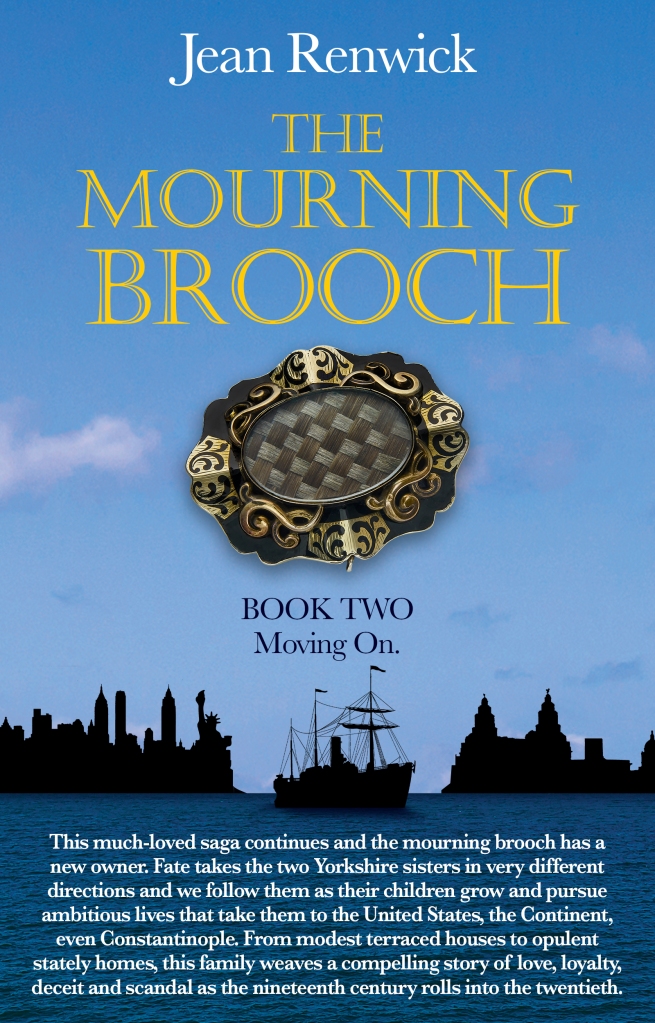
The cover design for Book One dictated the style for the sequel but this time the imagery reflects the family’s constant transatlantic travel, usually between Liverpool (silhouette of the Three Graces) and New York (Statue of Liberty against the 1900s skyline), with the Aurania plying her way back and forth. The rear cover shows the silhouette of Constantinople.
Two years on from launching The Mourning Brooch Book One – An ending. A beginning, I have published the second book in this trilogy about a real Yorkshire family. This sequel picks up the story in 1878 when the two sisters, Marian and Frannie, have young families; over the following 35 years we follow their lives as these children grow up to marry and have their own. Along the way, we witness how the business acumen of their husbands dictates their own path, for better or worse. Moving On chronicles the highs and lows the two women experience against the backdrop of national events of the day – the Jubilee then death of Queen Victoria, the Coronations of two successive Kings – as well as the local happenings of note – major strikes and industrial disasters. The book closes in 1913 as Europe faces unrest and uncertainty.
Researching and Writing The Mourning Brooch Book Two – Moving On
It has taken less time to write this sequel as much of the basic research was already done and, as with the earlier book, I have been supported by many friends and professionals who have been captivated by this tale of real people. However, as the story for some of the family crosses the Atlantic, I needed to understand the textile business in both Bradford and Philadelphia, each the centre of their nation’s wool industry. My principal researcher was John Cole, who diligently researched academic papers and industry journals to help me understand the intricacies of the wool trade, and trawled the newspaper archives to discover, yet again, more scandals (in Halifax and Southport) to reveal the nature of people identified through the records.
Local knowledge was provided generously by members of the family history societies of Doncaster & District, Bradford, and Liverpool & South West Lancashire. As the story spans the Atlantic, I have been fortunate to have the help of one such member, Sue Barry from Houston, Texas, skilled in genealogy, who provided valuable information including a bombshell mid-way through writing, which required going back thirty-six chapters to change the character of someone appearing on Page 1, and re-writing elements of the story to fit reality. Equally, Joanne Mullins, met through the links of Ancestry, has brought her important local knowledge of Philadelphia to check the accuracy of my writing. From California, the author, Selden Edwards, descendant of one of the family, provided invaluable material revealing, through excerpts of letters, the thoughts, personalities and lives of key players within the Willey family in Bradford and the USA.
The story follows the facts and I have travelled within England to discover more to add colour to my writing. My cousin, Keith Smith, who originally identified the Elizabeth Addy memorialised in the brooch, accompanied me to Holy Trinity in Sloane Square, where one of her granddaughters married, and we could appreciate the beauty of the famous Burne-Jones stained-glass window above the altar of this large church with its Art & Crafts influences. Talking with the staff persuaded me that the small wedding would have taken place up close to the altar, and I described it thus.
The bridegroom at that wedding was once under-butler to Lord Derby, serving in London and at Knowsley Hall near Liverpool. Derby House is now a suite of offices in St James’s Square and I was permitted to photograph what remains of the fine ceilings of the ground floor, once witness to elegant receptions for nobility and King Edward VII. The most exciting experience came with the visit on one of the few public open days to Knowsley Hall. My family came from Knowsley when it was still a small village, and were linked to Lord Derby as tenant farmers or working on his estate. Not only was I given the opportunity to view the many beautifully appointed reception rooms, I had exclusive access to the ‘below stairs’ area where that under-butler would have worked. This, together with the subsequent meeting with the curator and provision with further material, enabled me to expand upon the scenes set at the hall.
On-line research in the University of Bradford led me to the diary of Joseph Riley, a Bradford wool merchant, who detailed his 1889 journey on the Orient Express to meet his agent in Constantinople, world centre of the mohair trade. As I knew that a descendant of Elizabeth Addy was logged as returning from Constantinople a few years later, I borrowed from Riley’s writings to portray a similar journey for ‘my’ wool merchant and it makes dramatic reading.
Trawling through archives can be disappointing but the day spent at Bradford Archives produced a wealth of information discovered in a box of papers deposited by a leading firm of solicitors. The financial information has greatest relevance for Book Three, but guided me in understanding the business of the man in question during Book Two. After perusing each document, my hands were filthy with dust, but you can imagine my excitement in discovering such gems.
In Book One I regretted that I had not traced a living descendant of Elizabeth Addy but now I have. Sarah Halswell is descended through Marian Addy and has provided me with invaluable information to write Book Three which will run through the First World War and up to 1943 when the brooch was passed to my godmother, Dorothy Walker. Beyond that, the story would intrude into lives within living memory, for me a step too far.
Many more people have supported me with information and advice and they are listed in the book. Again, I have aimed for accuracy and to represent correctly the times covered by the story, but any errors are mine for which I apologise. In representing the people who once lived, I hope I have been respectful, unless press coverage demonstrated otherwise but in reality I do not know what they thought and spoke. That is the fiction of a novel.
Summer 2023
Jean Renwick
